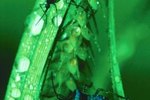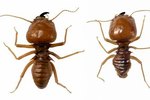
Depending on where you live, you may see the occasional stink bug when you wander outside, or you have a mob of these insects inside your house. With more than 4,500 stink bug species, you might think plenty of differences separate each stink bug variant, but they have mostly similar physical characteristics.
Color
Stink bugs come in a wide palette of colors, from lime green to inky black. Some have intense markings on their bodies, but most take on a fairly solid color. While many of the stinkbugs you'll encounter will likely take on a brownish appearance, the University of Florida notes that the green stink bug is the most commonly encountered species in the United States. It's a solid light green in color.
Body Length and Shield
Stinkbugs range slightly in size, generally coming in between 1/3 inch and and 3/4 inch in length, give or take a smidgen. The bugs are also known as shield bugs, and for good reason. The outer shell that covers them typically takes on a shieldlike appearance, either triangular or somewhat rounded in shape. On the back of that shell is a smaller shield, also triangular or somewhat rounded in shape. This is known as the scutella and it's essentially a hard piece of armor that protects a stink bug. Animal Planet notes that some stink bugs have scutellas so large they cover nearly their entire backs.
Antennae and Wings
Stink bugs have two antennae with five segments each. They use their antennae to help feel around in their environment. Most stink bugs have colored bands around their antennae. The insects sport three pairs of legs and two pairs of overlapping wings. The front wings are known as hemelytra -- the base of each wing is hardened; the tips, along with the entirety of the back wings, are thin and somewhat transparent.
Mouth
Stink bugs have piercing and sucking mouthparts. The majority use those parts to happily feed on plants and suck the juices out of them. Some stink bugs, however, take another path to finding dinner by seeking out and sucking the fluids right out of other insects.
Scent Glands
On a stink bug's thorax are scent glands. Pick up one of the insects and agitate it and you may smell a foul stench that you won't soon forget. When threatened, stink bugs release what Utah University Extension says is a "rancid liquid derived from cyanide compounds." The scent and taste ideally, for the stink bug at least, wards off predators.
References
Photo Credits
-
Photos.com/Photos.com/Getty Images
Writer Bio
Located in Pittsburgh, Chris Miksen has been writing instructional articles on a wide range of topics for online publications since 2007. He currently owns and operates a vending business. Miksen has written a variety of technical and business articles throughout his writing career. He studied journalism at the Community College of Allegheny County.




